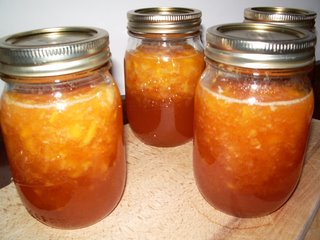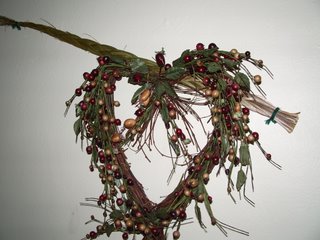
PEACH JAM
Every summer when we're doing just about nothing in the North Woods, SJG comes up with exactly one culinary challenge for our doing just about everything life. This year, she said, "Let's make peach jam." We've canned pickles, stewed tomatoes, harvest mix (stewed tomatoes, peppers, and garlic), and cranberry chutney, but never jam. So last weekend, we went to our favorite cooperative grocery to buy peaches and pectin to do just that. The next afternoon, a cool drizzly Sunday, we put up four pints of peach jam (above), as lovely in its amber glow as it is sweet and delicate on the tongue. Below is a recipe cobbled together from a variety of sources. Follow instructions carefully and make only one small batch at a time. (Note that peach season is pretty much over, though the jam will be very tasty with less than perfect fruit.)
Peach Jam
3 pounds fresh peaches, peeled and pitted
2 tablespoons lemon juice
1 packet pectin
5 cups white sugar
canning equipment (pint jars and screwtop lids and rings; kettles for cooking the peaches and sterilizing the jars; a metal canning ring for processing the jars after they've been filled; a plastic funnel; a ladle; tongs; a cooking fork; a rubber spatula)
1. Sterilize four or five pint jars in the dishwasher and leave them there until ready to use.
2. At the same time, set a large canning kettle full of water on the stove and bring to a boil. Bring a smaller kettle (8 quarts) of water to boil at the same time.
3. When the smaller kettle of water comes to a boil, set it in the sink and add the peaches. Let them sit in the water for a minute or two, then remove them, and while still warm, pull of the skins. It should slide right off.
4. Take out the pit of each peach and any brown or otherwise blemished sections. Remove the tough red fibers around the pits. Slice the peaches into chunks and place them in a large saucepan or 8-quart kettle. Mash the peaches with a potato masher, leaving some small chunks for texture. Add the lemon juice to the peaches and stir briefly.
5. Meanwhile, bring a small saucepan of water to a simmer and place the screwtop lids and rings in the water to allow them to sterilize while you're making the jam. The water in the large canning kettle should be boiling by now; place the pint jars in the boiling water and keep them there until ready to fill.
6. Add the pectin powder to the peaches and stir until dissolved over medium-high heat. Bring to a boil and add the sugar, stirring constantly.
7. Continuing to stir, bring the mixture to a full boil and allow to boil at a rolling boil for one minute.
8. Remove from the heat and skim off any foam with a slotted spoon.
9. Use a ladle to spoon the hot peach jam through a canning funnel into the sterilized pint jars, one at a time, leaving about 1/4- to 1/2-inch space between the top of the jam and the top of the rim of each jar. Use a rubber spatula to press out any air bubbles. Place a sterilized lid on top of the jar after you've filled it and carefully screw the accompanying ring onto the jar until finger tight.
10. When the jars are filled and capped, place them in the large canning kettle of boiling water, cover it, and boil for 10 minutes exactly. This helps prevent spoilage.
11. When the 10 minutes are up, turn off the heat and remove the cover of the canning kettle. When the water is no longer boiling and bubbles are no longer rising to the top (about three minutes), processing is complete.
12. Remove the jars with a pair of canning tongs and set them upright to cool and set undisturbed for 24 hours.
13. The next day, place the jars somewhere cool and dark for storage. Best eaten within the first six or eight months, after which time the jam will begin to darken and get runny.
* for extremely helpful tips, photos, recipes, and other useful information about canning, go to www.pickyourown.org

